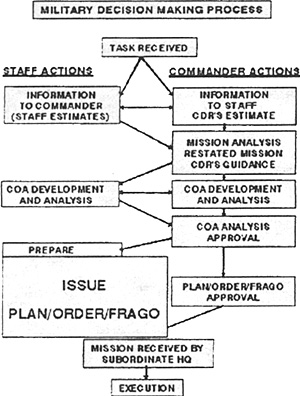
OBSERVATION:
Commanders and staffs should not take excessive time briefing operations orders.
DISCUSSION:
The order briefing is an event that, if not practiced and organized, takes an exorbitant amount of time. The commander and staff can make the briefing quick and clear by reducing distractions, sequencing the briefers, and using graphic aids. The commander selects the location of the operations order brief and can reduce distractions by his decision. However, his practical options are to brief at a vantage point or at the tactical operations center (TOC). When possible, the commander presents the order at a vantage point. This helps subordinates understand the order by decreasing distractions and by viewing the terrain as the operation is explained to them.
If a vantage point is selected, use the terrain to your advantage by first arranging maps and overlays so they don't obstruct the audience's view of the area of operation. Second, begin the order brief by orienting everyone to key terrain features. And third, identify a key piece of terrain when it is mentioned during the order briefing, both on the map and in the area of operation.
If the commander decides to give the briefing in the TOC, prepare the briefing area to reduce distractions. Clear the TOC to provide room for the staff to brief and to fit all attending subordinates. In a heavy unit, ensure that all vehicle ramps are up and radio operators use head sets to reduce radio volume. Shut down vehicles and generators or sandbag generators to silence them as much as possible. All of these precautions will allow the commander and staff to give the order with limited noise.
To speed and better explain the order, organize the staff in a sequence to follow the order format. The commander determines whether to issue the written order before or after the briefing because there are advantages and disadvantages to both methods. If provided before the order, a subordinate commander can give it to an assistant or LO to return to the company or TOC. The staff can then begin its preparations. However, the written order can also become a distraction when subordinates attempt to read it during the briefing.
Sequence the staff for the briefing to closely follow the five-paragraph order. The following is an example:
- CDR (XO) GIVES TASK ORGANIZATION, SITUATION (FRIENDLY FORCES), AND MISSION
S-2 GIVES TOC TIME, IPB (EXCEPT DECISION SUPPORT TEMPLATE)
CDR COMMANDER'S INTENT
S-3 EXECUTION' (CONCEPT OF OPERATION, SCHEME OF MANEUVER)
FSO FIRES
ENGINEER MOBILITY, COUNTERMOBILITY, AND SURVIVABILITY PLANS
ADAO AIR DEFENSE PLAN AND ENEMY AIR SITUATION
S-2 COLLECTION
CHEMICAL NBC
S-3 COORDINATING INSTRUCTIONS
S-4 SERVICE SUPPORT
XO COMMAND AND SIGNAL AND REVIEW' OF PREPARATION TIME LINE
CDR REVIEW OF COMMANDER'S INTENT AND DECISION SUPPORT TEMPLATE
The commander controls the audience, limiting questions and stopping questions that will distract from the briefing. Although the commander gives his intent during the briefing, he reviews it to provide detailed guidance to each subordinate. The commander expresses his intent by repeating specific tasks and purposes for subordinates and emphasizing the results. The commander then ties each task together in sequence to explain how he expects to accomplish the mission. By addressing each subordinate, the commander ensures that each one understands how his mission relates to the commander's intent. Also, reviewing commander's intent at the end of the briefing will stimulate questions.
 "Whenever possible, subordinate leaders should receive their orders face to face from their commanders on the ground chosen for the operation."
"Whenever possible, subordinate leaders should receive their orders face to face from their commanders on the ground chosen for the operation."
- --FM 100-5
Battalion and brigade staffs can expect to brief from 15 to 30 people, making the 1:50,000 scale map impractical to use as the only graphic aid. To display the detail necessary to explain the plan, use either a 1:10,000 scale, an enlarged 1:50,000 scale map, or a sketch. For frequently used training areas, have the Training Aids Support Center (TASC) enlarge the required map or enlarge it using a photo copier. A simpler method is to draw sketches for the areas that will be highlighted during the order. For example, sketch critical events, such as the breach or assault on the objective, on butcher paper to show the detail of the plan.
To assist the staff in briefing the plan, the S-3 can use charts with the unit's mission and task organization. This helps especially when the order is not accompanied with a written order, or the written order is given to subordinates after the briefing.
LESSONS:
- Commander: When feasible, use a vantage point to brief the operations order. It will reduce distractions and allow subordinates to see the terrain.
- Staff: Organize the briefing to follow the written order format.
- Commander: Control the briefing to stop distractions.
- Commander: Review your intent and address' each subordinate directly to ensure he understands how his mission relates to your intent.
- Staff: Use graphic aids to better present the order.
Back to Table of Contents -- Battalion and Brigade Battle Staff
Back to CALL List of Issues
Back to MagWeb Magazine List
© Copyright 2004 by Coalition Web. Inc.
This article appears in MagWeb.com (Magazine Web) on the Internet World Wide Web.
Other articles from military history and related magazines are available at http://www.magweb.com